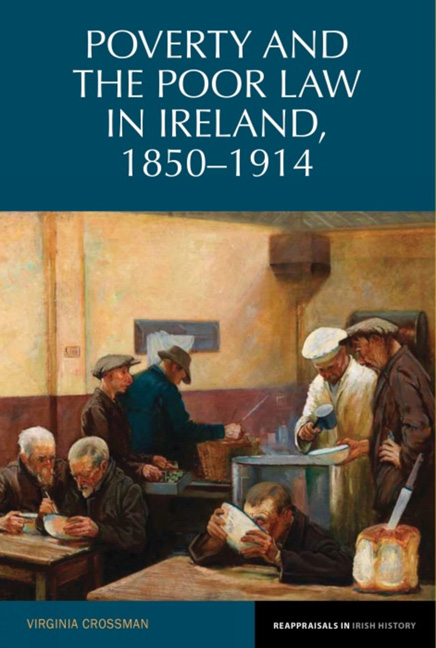Book contents
- Frontmatter
- Contents
- List of Figures
- List of Tables
- List of Maps
- Acknowledgements
- Introduction
- Chapter 1 Concepts of Poverty and Poor Relief
- Chapter 2 Context and Trends
- Chapter 3 Outdoor Relief
- Chapter 4 The Workhouse
- Chapter 5 The Sick, Infirm and Lunatics
- Chapter 6 Single Mothers and Prostitutes
- Chapter 7 Mendicancy and Vagrancy
- Conclusion
- Note on statistics and Sources
- Bibliography
- Index
Chapter 2 - Context and Trends
- Frontmatter
- Contents
- List of Figures
- List of Tables
- List of Maps
- Acknowledgements
- Introduction
- Chapter 1 Concepts of Poverty and Poor Relief
- Chapter 2 Context and Trends
- Chapter 3 Outdoor Relief
- Chapter 4 The Workhouse
- Chapter 5 The Sick, Infirm and Lunatics
- Chapter 6 Single Mothers and Prostitutes
- Chapter 7 Mendicancy and Vagrancy
- Conclusion
- Note on statistics and Sources
- Bibliography
- Index
Summary
The impact of the Great Famine (1845–1850) was profound and shaped attitudes to relief long after the crisis had passed. Workhouses became associated in the popular mind with death and disease, while outdoor relief became associated in the establishment mind with widespread abuse and fraudulent claims. The introduction of outdoor relief, together with other reforms introduced during the course of the Famine changed the way that the poor law system operated. Before examining the nature and extent of that change and in order to provide a context for the discussion that follows, it is necessary to give a brief overview of social and economic developments in post-Famine Ireland. Population levels fell dramatically during the Famine and continued to fall well into the twentieth century, due primarily to consistently high levels of emigration. Having reached over 8 million prior to the famine, total population figures had dropped to 4.4 million by 1911. Subsistence agriculture declined in the post-Famine period and the average size of landholdings increased. In 1845 holdings of between one and fifteen acres made up 55 per cent of farms. By 1853 this figure had fallen to 44 per cent and by 1902 to 37 per cent. Holdings over fifteen acres increased from 31 per cent of farms in 1845, to 51 per cent in 1902. Changes in landholding were accompanied by changes in the type of farming undertaken. Pasture replaced tillage in many parts of the country. The number of agricultural labourers declined by 20 per cent between 1841 and 1851, and continued to decline in subsequent decades. Samuel Clark estimates that the proportion of labourers within the male agricultural labour force as a whole fell from 56 per cent in 1841, to 38 per cent in 1881, while that of farmers and farmers’ sons rose from 42 per cent to 60 per cent. Those who survived the Famine saw significant economic and social progress in subsequent decades but this was neither distributed evenly nor experienced equally. Despite their decline in numbers, the circumstances of agricultural labourers appear to have improved less quickly and less noticeably than those of farmers.
- Type
- Chapter
- Information
- Poverty and the Poor Law in Ireland, 1850–1914 , pp. 33 - 62Publisher: Liverpool University PressPrint publication year: 2013



